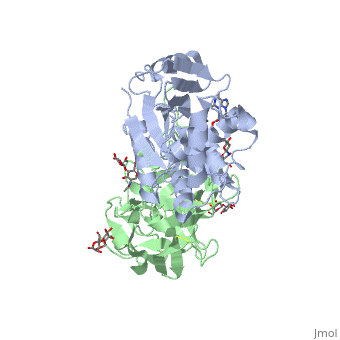Sandbox BCMB402 Ricin
From Proteopedia
| Line 19: | Line 19: | ||
Once the A chain gains entry into the cytosol its mechanism for attack of the [[Ribosome|ribosome]] is depurination of a single adenosine residue in a highly conserved portion within the large RNA of the cytoplasmic [[Large Ribosomal Subunit of Haloarcula|large ribosomal subunit]]<ref name="rapak" /> of eukaryotes; in human, the large cytoplasmic ribosomal RNA is called the 28S ribosomal RNA because of its sedimentation properties during ultracentrifugation. The nucleotide depurinated is located within a specific, conserved loop referred to as the <nowiki>'</nowiki>sarcin-ricin loop<nowiki>'</nowiki>; the loop is critical for binding [[elongation factors|elongation factors]] during [[Translation|translation]] of messenger RNA to protein <ref name="holmbergnygard">PMID: 8648651</ref>. Depurination of the single adenosine nucleotide by the toxin results in the inhibition of protein synthesis. | Once the A chain gains entry into the cytosol its mechanism for attack of the [[Ribosome|ribosome]] is depurination of a single adenosine residue in a highly conserved portion within the large RNA of the cytoplasmic [[Large Ribosomal Subunit of Haloarcula|large ribosomal subunit]]<ref name="rapak" /> of eukaryotes; in human, the large cytoplasmic ribosomal RNA is called the 28S ribosomal RNA because of its sedimentation properties during ultracentrifugation. The nucleotide depurinated is located within a specific, conserved loop referred to as the <nowiki>'</nowiki>sarcin-ricin loop<nowiki>'</nowiki>; the loop is critical for binding [[elongation factors|elongation factors]] during [[Translation|translation]] of messenger RNA to protein <ref name="holmbergnygard">PMID: 8648651</ref>. Depurination of the single adenosine nucleotide by the toxin results in the inhibition of protein synthesis. | ||
| - | The proposed mechanism of depurination utilizes the <scene name='Sandbox_BCMB402_Ricin/Conserved_residues/2'>conserved residues</scene> in the A chain. The aromatic ring structures of the substrate adenosine stack with the aromatic side chains of <scene name='Sandbox_BCMB402_Ricin/Tyr_stacking/1'>two tyrosine residues</scene>, Tyr 80 and 123, above and below. Hydrogen bonds form between the conserved arginine and a backbone carbonyl. The depurination reaction is aided by the protonation of N3 by Arg 180 and by ion pairing to Glu 177. A water molecule on the opposite side of the ribose is activated by hydrogen bonding to Arg 180. The activated water attacks C1' of the ribose, releasing the adenine and depurinated RNA fragment. | + | The proposed mechanism of depurination utilizes the <scene name='Sandbox_BCMB402_Ricin/Conserved_residues/2'>conserved residues</scene> in the A chain. The aromatic ring structures of the substrate adenosine stack with the aromatic side chains of <scene name='Sandbox_BCMB402_Ricin/Tyr_stacking/1'>two tyrosine residues</scene>, Tyr 80 and 123, above and below. Hydrogen bonds form between the conserved arginine and a backbone carbonyl. The depurination reaction is aided by the protonation of N3 by Arg 180 and by ion pairing to Glu 177. A water molecule on the opposite side of the ribose is activated by hydrogen bonding to Arg 180. The activated water attacks C1' of the ribose, releasing the adenine and depurinated RNA fragment. This interferes with elongation factor binding to the ribosome, thus inhibiting [[translation|translation]]. |
</StructureSection> | </StructureSection> | ||
Revision as of 20:12, 24 April 2013
Ricin is a potent cytotoxin that is synthesized in the endosperm cells of maturing seeds of the castor oil plant (Ricinus communis)[1]. Ricin belongs to a small multi-gene family[2] that is composed of eight members. Ricin is classified as a type II heterodimeric Ribosome Inactivating Protein[1] or RIPs. For toxins in Proteopedia see Toxins.
| |||||||||||
Updated April 2013
Ricin A chain (RTA)
1j1m, 1ift, 2aai, 1rtc – RTA
3lc9, 3mk9, 2vc4, 1uq4, 1uq5, 1obs, 3bjg, 3srp – RTA (mutant)
Ricin A chain binary complexes
3px8 – RTA preproricin + 7-carboxy-pterin
1br5, 1br6 - RTA + pterin derivative
3px9 - RTA preproricin + furanylmethyl-carbamoyl-pterin
3lc9, 3mk9, 2vc4, 1uq4, 1uq5, 1obs – RTA (mutant)
3hio – RTA + tetranucleotide
3ej5, 1il5 – RTA pyrimidine derivative
2p8n, 1ifs – RTA + adenine
2pjo, 2r2x – RTA + urea derivative
2r3d – RTA + acetamide
2vc3 - RTA (mutant) + acetate
1il3, 1il4, 1il9 – RTA + guanine derivative
1ifu, 1fmp – RTA + formycin
1obt - RTA (mutant) + AMP
1apg – RTA + RNA
3px8 – RTA + formycin monophosphate
Ricin B chain (RTB)
3nbc, 3nbd – CnRTB + lactose – Clitocybe nebularis
3nbe – CnRTB + lactose derivative
3phz – RTB + glycoside – Polyporus squamosus
Ricin A+B chains
2aai - RTA + RTB
3rtj - RTA + RTB + dinucleotide
See Also
References
- ↑ 1.0 1.1 1.2 1.3 Lord JM, Roberts LM, Robertus JD. Ricin: structure, mode of action, and some current applications. FASEB J. 1994 Feb;8(2):201-8. PMID:8119491
- ↑ 2.0 2.1 2.2 Montfort W, Villafranca JE, Monzingo AF, Ernst SR, Katzin B, Rutenber E, Xuong NH, Hamlin R, Robertus JD. The three-dimensional structure of ricin at 2.8 A. J Biol Chem. 1987 Apr 15;262(11):5398-403. PMID:3558397
- ↑ Weston SA, Tucker AD, Thatcher DR, Derbyshire DJ, Pauptit RA. X-ray structure of recombinant ricin A-chain at 1.8 A resolution. J Mol Biol. 1994 Dec 9;244(4):410-22. PMID:7990130 doi:http://dx.doi.org/10.1006/jmbi.1994.1739
- ↑ Rutenber E, Ready M, Robertus JD. Structure and evolution of ricin B chain. Nature. 1987 Apr 9-15;326(6113):624-6. PMID:3561502 doi:http://dx.doi.org/10.1038/326624a0
- ↑ 5.0 5.1 Rapak A, Falnes PO, Olsnes S. Retrograde transport of mutant ricin to the endoplasmic reticulum with subsequent translocation to cytosol. Proc Natl Acad Sci U S A. 1997 Apr 15;94(8):3783-8. PMID:9108055
- ↑ Holmberg L, Nygard O. Depurination of A4256 in 28 S rRNA by the ribosome-inactivating proteins from barley and ricin results in different ribosome conformations. J Mol Biol. 1996 May 31;259(1):81-94. PMID:8648651 doi:10.1006/jmbi.1996.0303

